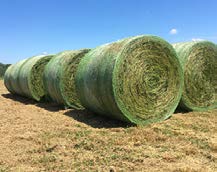Baleage Production Tips

Baleage season has started in the southern U.S., and it is important to remember that baleage allows you to preserve harvested forages. Baleage is not for improving the nutritive value of your forage crop, but to preserve it. With that said, if you are producing low-quality forage and you ensile it, you will have low-quality baleage when you feed it.
Ensiling forage (making baleage) allows you to preserve the harvested forage with minimum nutrient and harvest losses. Here are some tips to keep in mind when making good baleage:
- Cut your annual ryegrass or small grains at the boot stage.
- Bale and wrap your forage crop at a moisture content ranging from 40 to 60 percent, but 50 percent is ideal.
- Make sure that you do not cut more than you can bale and wrap in a day. The sooner the bales are wrapped, the better. The maximum time the bales should sit before wrapping is 12 hours. If too much time passes, the bales will spoil rather than ferment.
- Remember that bales will contain more water; consider making smaller bales for easy handling and to avoid breaking the wrap while transporting them to the storage location.
- If the bales are not tight and the plastic is not stretched and sealed, oxygen may continue to enter the system. In this case, respiration will continue to occur, and heat will continue to be produced. Use a film that is at least 75 percent pre-stretch and that has good reflective UV properties.
- When wrapping single bales, make sure you use a minimum of four to six wraps of film. The recommendation is 6.
- The maximum bale storage for single bales is two high.
- When doing in-line wrapping, make sure that you use a minimum of six to eight wraps of film. The recommendation is eight.
- After baling, wrapping, and storing is complete, inspect the individual bales or the in-line tubes for any possible punctures or holes, and seal them to avoid oxygen intake, bad fermentation (butyric acid), and spoilage.
- It takes at least 35 days for the pH to get low enough to stop all microbial growth and reduce fermentation. At this point, the fermentation process is complete, and bales can be opened and fed.
- Forage crops baled at 40 to 60 percent moisture will maintain feed value for about 12 months if the integrity of the plastic is maintained.
The advantage of baleage is that you can harvest a wide range of forage crops at a stage of greater nutritive value without depending on the weather for proper curing. This is especially important with the springtime conditions in the South.
Even though baleage is a high-moisture feed, there is an opportunity to increase your dry matter yield per acre. Compared to dry hay, baleage has lower leaf and sugar loss from respiration during long drying periods. Although baleage is not for everyone, there is a potential to lower harvesting losses and feeding costs when baleage is done correctly.
Remember: Baleage only preserves—it does not enhance—forage quality!
Publication 3260 (POD-08-23)
By Rocky Lemus, PhD, Extension/Research Professor, Plant and Soil Sciences.
The Mississippi State University Extension Service is working to ensure all web content is accessible to all users. If you need assistance accessing any of our content, please email the webteam or call 662-325-2262.



